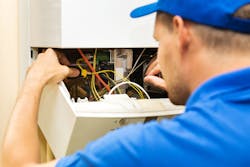Keep the Heat on With Maintenance Programs
By Ron Johnson
Whether it’s shopping for televisions, cars, or the best local pizza, happy customers are return customers. For plumbing and heating professionals, one way to keep a homeowner or business as a long-term client is through a well-conceived maintenance program.
Perhaps more than ever, maintenance programs are an important part of the package that should be offered by plumbing and heating professionals. Especially in the case of high efficiency boilers, it’s important to ensure that all components operate as designed. That includes fans, filters, coils, heat exchanger, igniters, gas valves, and temperature sensors. As heating systems become more complex, it’s certainly to the client’s advantage to keep units in top condition.
Many appliance manufacturers now even require yearly maintenance to safeguard against harmful situations that would jeopardize the operation of the appliance. Ariston’s subsidiary is no exception—HTP heating products require yearly maintenance on their appliances. These programs help ensure the appliance is operating at peak performance for many years. If something in the unit did change, a yearly maintenance review will catch it and correct deficiencies.
Both Sides of the System
Maintenance programs entail looking hydro side and combustion side and there’s a simple reason why. Water is very corrosive and dirty. Contaminants can block passageways in boilers, combination units, tankless units, and other passageways such as pumps and mixing valves.
Flushing the water side of the unit and systems ensures that the right PSI is being delivered. It will also help remove scale buildup inside the tubes that allow water to circulate for heating and domestic hot water applications. Blocked passageways often cause nuisance issues that a plumber will eventually need to correct.
For tank type water heaters such as the Phoenix and Everlast Product from HTP, dirty water can produce layers of sediment on the heater transferring areas in the water heater. When this happens the water heater must work harder to meet demand.
Yearly inspection involves cleaning the bottom heads or pans for gas units, heat exchanger coils for high efficiency models, and elements for electric models to ensure maximum heat transfer to water. Maximizing heat transfer of water ensures the unit is operating at peak performance and helps the end user curb energy costs.
Maintenance programs for combustion side or gas side are vastly different from the water side. For combustion, it’s important to clean burners, coils, heat exchangers, and other components from dirty or contaminated air. Also, low gas pressure can often lead to “smut” build up on essential components such as ignitors and flame sensors that will, over time, deteriorate rapidly due to poor burn.
“Smut” is a byproduct of combustion flames that occurs due to incomplete burn of the flame. Overly rich mixtures can cause yellow tips, and those tips leave black smoke that will attach to components. This needs to be corrected and cleaned through the yearly maintenance program. Yearly cleaning of heat exchangers should occur to make sure heat can be transferred to the water in the most efficient way possible. Cleaning most heat exchangers involves some form of washing coils, and each manufacturer should outline these procedures in use and care manuals.
The Installer Should Maintain
Installing contractors are the best individuals to sell and service the maintenance program. This will be the person that is most familiar with the system and will ensure a seamless transition from installation to maintenance and cleaning. The installing contractor can determine the ideal schedule for the maintenance program by evaluating many factors at the job. The two biggest factors are water chemistry and gas delivery.
Installations with poor water quality or lower gas pressure may require six month checks versus yearly. Also, the installing contractor may provide discounts if you sign up at installation, or even offer it for free depending on the original contract or sales price.
Not every home or business owner is going to buy into a maintenance program. They should be aware, however, of several important points. One, it makes economic sense to invest in it. Installation costs of a new water heater exceed $1,200 in some parts of the country. Add in the cost of a new unit, and they are staring directly at a significant expense—probably at least $2,000. The average cost to replace a residential boiler can be between $4,000 and $9,000 depending on the location.
Not a DIY Job
Some people are going to skip maintenance by a professional and attempt to do the work themselves. Bad idea. Why? Most use and care manuals state that a licensed contractor should install and service the appliance. Work performed by unlicensed people, while well-intentioned, voids the service warranty.
Work by unlicensed people is also unsafe. Maintenance programs involve removing parts and pieces to get to the internal components that need replacing. Licensed contractors are usually trained by the manufacturer on how to take the units apart and properly reassemble them. Relying on homemade videos for work on highly combustible and complex technical heating products, especially with gas units, is an alarming safety concern and presents an unneeded risk.
While most maintenance programs are similar, the frequency of visits can be adjustable. Most manufacturers require at least a yearly maintenance service to maintain the warranty of the appliance. Maintenance programs can be as creative as the end user wants, but to protect the unit maintenance should be done at a minimum of once every year.
The bottom line is that by ensuring an efficient heating system, people might even find money savings that could allow them to purchase that new car—or, at the very least, more multi-topping pizzas from their favorite haunt.
Ron Johnson, MBA, PMP, is the National Training Manager for Ariston Thermo in the United States. A graduate of Troy University, Johnson has more than 20 years in Product Management experience and has collaborated with multi-departmental teams for plumbing and HVAC projects to design, develop, implement and evaluate new product introductions to solve market requirements.
